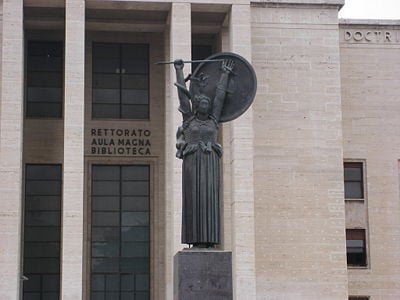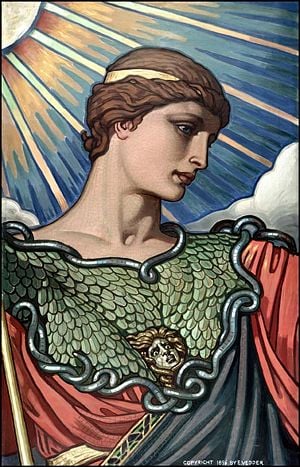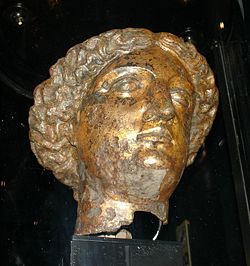Difference between revisions of "Minerva" - New World Encyclopedia
(imported offline work) |
m (moved some material) |
||
| Line 3: | Line 3: | ||
[[Image:Head of Minerva.jpg|right|thumb|300px|Head of Minerva by [[Elihu Vedder]], 1896]] | [[Image:Head of Minerva.jpg|right|thumb|300px|Head of Minerva by [[Elihu Vedder]], 1896]] | ||
| − | '''Minerva''' was a [[Roman mythology|Roman]] [[goddess]] of crafts, poetry and wisdom, and is known as the inventor of music. She was considered to be the virgin goddess of [[war]]riors, [[poetry]], [[medicine]], [[wisdom]], [[commerce]], [[craft]]s, and the [[inventor]] of [[music]]. Like many of the figures of Roman mythology, Minerva's character and function was largely appropriated from the Greek tradition, and she is similar to virtually identical to [[Athena]], the goddess of wisdom and warriors in the Greek pantheon | + | '''Minerva''' was a [[Roman mythology|Roman]] [[goddess]] of crafts, poetry and wisdom, medicine and is known as the inventor of music. She was considered to be the virgin goddess of [[war]]riors, [[poetry]], [[medicine]], [[wisdom]], [[commerce]], [[craft]]s, and the [[inventor]] of [[music]]. As ''Minerva Medica'', she was the goddess of medicine and doctors. Like many of the figures of Roman mythology, Minerva's character and function was largely appropriated from the Greek tradition, and she is similar to virtually identical to [[Athena]], the goddess of wisdom and warriors in the Greek pantheon. |
==History== | ==History== | ||
| Line 9: | Line 9: | ||
The name "Minerva" is likely imported from the [[Etruscan religion|Etruscans]] who called her [[Menrva]]. The Romans would have easily confused her foreign name with their word ''mens'' meaning "mind" since one of her aspects as goddess pertained not only to war but also to the intellectual. | The name "Minerva" is likely imported from the [[Etruscan religion|Etruscans]] who called her [[Menrva]]. The Romans would have easily confused her foreign name with their word ''mens'' meaning "mind" since one of her aspects as goddess pertained not only to war but also to the intellectual. | ||
| + | |||
| + | It was only when she was identified with the Greek goddess Athena did she gain the character as a goddess of war and combat. The name "Minerva" may derive from the Indo-European root 'men', from which "mental" and "mind" are also derived. However, it is more likely imported from the non-Indo-European speaking [[Etruscan religion|Etruscans]], who called their goddess of the arts Menrva. The Romans would have easily confused her foreign name with their word ''mens'' meaning "mind", since one of her aspects as goddess pertained to the intellectual. | ||
| + | |||
| + | ==Mythology== | ||
Adapting Greek myths about [[Athena]], Romans said that Minerva was not born in the usual way, but rather Jupiter had a horrible headache and [[Vulcan (mythology)|Vulcan]] opened up his head and out came Minerva, fully grown, and dressed in armor, a long trailing robe, a helmet, a shield and a spear. | Adapting Greek myths about [[Athena]], Romans said that Minerva was not born in the usual way, but rather Jupiter had a horrible headache and [[Vulcan (mythology)|Vulcan]] opened up his head and out came Minerva, fully grown, and dressed in armor, a long trailing robe, a helmet, a shield and a spear. | ||
Revision as of 16:57, 15 August 2007
Minerva was a Roman goddess of crafts, poetry and wisdom, medicine and is known as the inventor of music. She was considered to be the virgin goddess of warriors, poetry, medicine, wisdom, commerce, crafts, and the inventor of music. As Minerva Medica, she was the goddess of medicine and doctors. Like many of the figures of Roman mythology, Minerva's character and function was largely appropriated from the Greek tradition, and she is similar to virtually identical to Athena, the goddess of wisdom and warriors in the Greek pantheon.
History
(Please add a history section)
The name "Minerva" is likely imported from the Etruscans who called her Menrva. The Romans would have easily confused her foreign name with their word mens meaning "mind" since one of her aspects as goddess pertained not only to war but also to the intellectual.
It was only when she was identified with the Greek goddess Athena did she gain the character as a goddess of war and combat. The name "Minerva" may derive from the Indo-European root 'men', from which "mental" and "mind" are also derived. However, it is more likely imported from the non-Indo-European speaking Etruscans, who called their goddess of the arts Menrva. The Romans would have easily confused her foreign name with their word mens meaning "mind", since one of her aspects as goddess pertained to the intellectual.
Mythology
Adapting Greek myths about Athena, Romans said that Minerva was not born in the usual way, but rather Jupiter had a horrible headache and Vulcan opened up his head and out came Minerva, fully grown, and dressed in armor, a long trailing robe, a helmet, a shield and a spear.
Worship
Minerva was worshipped throughout Italy, though only in Rome did she take on a warlike character. Her worship was also taken out to the empire - in Britain, for example, she was conflated with the wisdom goddess Sulis. Minerva was also worshipped on the Capitoline Hill as one of the Capitoline Triad along with Jupiter and Juno, at the Temple of Minerva Medica, and at the "Delubrum Minervae" a temple founded around 50 B.C.E. by Pompey on the site of the church of Santa Maria sopra Minerva (near the present-day Piazza della Minerva and the Pantheon).
The Romans celebrated her festival from March 19 to March 23 during the day which is called, in the feminine plural, Quinquatria, the fifth after the Ides of March, the nineteenth, the artisans' holiday. A lesser version, the Minusculae Quinquatria, was held on the Ides of June, June 13, by the flute-players, who were particularly useful to religion. In 207 B.C.E., a guild of poets and actors was formed to meet and make votive offerings at the temple of Minerva on the Aventine hill. Among others, its members included Livius Andronicus. The Aventine sanctuary of Minerva continued to be an important center of the arts for much of the middle Roman Republic. However, with the acknowledgement of Christianity as the state religion of Rome in the 4th century, worship of the various polytheistic dieties including Minerva faded into oblivion.
Interestingly enough, worship of Minerva resurfaced in the early 20th century in Gautemala, of all places. During this time, Manuel José Estrada Cabrera, President of Guatemala, tried to promote a "Cult of Minerva" in his country. This movement left little legacy other than a few interesting Hellenic style "Temples" in parks around Guatemala.
Temples
Several famous temples dedicated to the goddess Minerva once existed in the ancient world, especially in Rome.
The temple of Minerva Medica (akin to the temple of Apollo Medicus) was a Roman temple built on the Esquiline Hill in the republican era (cf. Cic. de div. II.123: sine medico medicinam dabit Minerva, and CIL VI.10133, 30980), though no remains of it have been found. It has since the 17th century been wrongly identified with the ruins of a nymphaeum on a nearby site (see picture inset), on account of the erroneous impression that the Athena Giustiniani had been found in its ruins (HJ 360; LS III.158‑161).
The site of another ancient Minerva Temple in Rome is now today a famous Christian church. The Santa Maria sopra Minerva is a basilica church in Rome, which gets its name because, like many early Christian basilicas, it was built directly over (sopra) the foundations of a temple dedicated to the goddess Minerva. Details of the ruined temple to Minerva, built by Pompey about 50 B.C.E., referred to as Delubrum Minervae are not known.
In Assisi, another church of Santa Maria sopra Minerva was built in the 16th century within the surviving cella of a late Republican temple of Minerva. Its Corinthian portico still stands.
Influence

Although Minerva is no longer worshipped, she has persisted as one of the Roman dieties most commonly alluded to among the cogniscenti and their folds. As patron goddess of wisdom, Minerva is frequently featured at educational establishments in the form of a statue, or as an image on seals, among other forms. For example, a statue of Minerva is located in the center of La Sapienza University, the most important university of Rome. Minerva is also displayed in front of Columbia University's Low Library as "Alma Mater." Minerva decorates the keystone over the main entrance to the Boston Public Library, the original public-financed library in America, beneath the words, "Free to all." Minerva is featured on the seals and logos of many institutions of higher learning, such as the University of Lincoln in the United Kingdom, the University at Albany, The State University of New York, the University of Alabama and Union College, New York, among others. Minerva is the logo of the world famous German "Max Planck Society for the Advancement of Science".
Minerva is also alluded to in numerous academic publications and literary works. For instance, Minerva is a triannual magazine for members of the Royal Dublin Society. Minerva is also a section heading in the British Medical Journal, alluding to her healing powers. In a similar vein, Minerva Medica is the name of an Italian publisher of medical journals and books. The journal of the Special Air Service Regiment of the British Army is "Mars and Minerva", taking its name from the regimental badge of the Artists' Rifles. Numerous literary and popular fictional characters, have been named after Minerva, usually related to computers or genius.
ReferencesISBN links support NWE through referral fees
- Grant, Michael & Hazel, John. Who's Who in Classical Mythology. London: Weidenfeld & Nicolson, 1973. ISBN 0297766007
- Grimal, Pierre. A Concise Dictionary of Classical Mythology. Cambridge, M.A.: Blackwell, 1990. ISBN 0631166963
- Lenardon, Robert J, et al. A Companion to Classical Mythology. New York: Oxford University Press, 1996. ISBN 978-0195147254
- Morford, Mark P. O. & Lenardon, Robert J. Classical Mythology. New York: Oxford University Press, 2002. ISBN 978-0195153446
- Scheid, John. An Introduction to Roman Religion. Bloomington, I.N.: Indiana University Press, 2003. ISBN 0253216605
External Links
Credits
New World Encyclopedia writers and editors rewrote and completed the Wikipedia article in accordance with New World Encyclopedia standards. This article abides by terms of the Creative Commons CC-by-sa 3.0 License (CC-by-sa), which may be used and disseminated with proper attribution. Credit is due under the terms of this license that can reference both the New World Encyclopedia contributors and the selfless volunteer contributors of the Wikimedia Foundation. To cite this article click here for a list of acceptable citing formats.The history of earlier contributions by wikipedians is accessible to researchers here:
- Minerva history
- Santa_Maria_sopra_Minerva history
- Temple_of_Minerva_Medica history
- Temple_of_Minerva_Medica_(temple) history
The history of this article since it was imported to New World Encyclopedia:
Note: Some restrictions may apply to use of individual images which are separately licensed.


